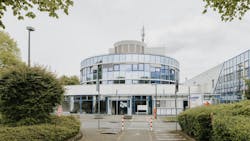LED manufacturer Nichia has announced the opening of its Nichia Automotive Innovation Center in Aachen, Germany. Fully owned by Nichia Corporation, the center is expected to work closely with Nichia’s Japan R&D team, key customers, and academic partners to prioritize and accelerate the development of automotive lighting technology.
A spokesperson for Nichia indicated that the location was selected for its proximity to key automotive innovators and customers. “Aachen, centrally located with excellent transport and travel connections to numerous companies and research institutes in the region, is a prime hub for these advancements. Additionally, Aachen is home to a successful university, including the FH Aachen and the Fraunhofer Institute, providing excellent access to local academic talent,” the spokesperson said.
In today’s announcement, Dr. Ulf Meiners, managing director, Nichia Automotive Innovation Center, said, “The key to unlocking the full potential of automotive lighting lies in collaboration. By working closely with business partners and academia, we will bring groundbreaking solutions to the market faster and more efficiently than ever before.”
The Nichia spokesperson noted that center collaborators include “a long list of Tier 1s, OEMS, and design partners along with universities,” declining to identify partners by name due to nondisclosure protections.
As a result of these relationships, Meiners added, “[The center] can rapidly accelerate the pace of innovation. Industry leaders that are ready to redefine automotive lighting standards need to connect with us with great urgency to truly shape the future.”
Growth market
Nichia said its new center will focus on sustainable lighting solutions that address energy efficiency, visual comfort, road safety, aesthetics, and functionality. The center is staffed with experts in automotive lighting who will optimize product designs and employ value engineering principles as needed to ensure both fast time-to-market and high light quality. It is equipped with rapid prototyping equipment as well as testing, modeling, and analysis tools to support customers in the rapidly evolving and growing automotive market.
According to market researchers Mordor Intelligence, the global automotive LED lighting market is expected to reach US$8.97 billion in 2024, with a compound annual growth rate of 8.13% from 2024 to 2030, compared to 3.04% over the period from 2017 to 2023. Over the past several years, headlights have garnered the lion’s share of the market and will continue to do so, driven by government regulations and safety concerns, the firm said in its growth trends and forecast summary.
Prospective automotive advances
Although Nichia did not specify in today’s announcement what product developments are underway, LEDs Magazine has reported that both Nichia and ams Osram have engineered micro LED technology for the auto environment. Back in 2019, the LED makers announced progress in micro LED-based, adaptive headlamp modules with controllable pixels. Nichia partnered with Infineon to integrate 16,000 individually controllable micro LEDs with the latter’s driver IC technology, while the former Osram Opto Semiconductors (pre-ams acquisition) said its existing Eviyos array would evolve to incorporate 25,000 pixels — which it confirmed last summer.
Individually controllable LEDs in automotive arrays could deliver advanced safety features such as reduced headlamp glare from oncoming vehicles, improved illumination around curved roadways, and message projection for road condition or hazard warnings.
Furthermore, increasing awareness of the impact of lighting on human health, wellbeing, and alertness may drive design efforts into interior LED applications, such customizable lighting schemes for both traditional and autonomous vehicles, in addition to infrared sensing for driver awareness.
CARRIE MEADOWS is editor-in-chief of LEDs Magazine, with 20-plus years’ experience in business-to-business publishing across technology markets including solid-state technology manufacturing, fiberoptic communications, machine vision, lasers and photonics, and LEDs and lighting.
Follow our LinkedIn page for our latest news updates, contributed articles, and commentary, and our Facebook page for events announcements and more. You can also find us on the X platform.






